Top 3 Tips on Weight Shift Takeaway to Follow Through
The Weight Shift during the golf swing is one of the primary sources for power. When done correctly and in the proper sequence, it can dramatically affect the distance of your shots. However, when done incorrectly you will find the game frustrating as you struggle to find consistency.
Your Weight shift starts from the ground up and is the foundation to proper biomechanics in the swing. The two major swing flaws with improper weight shift is a Sway or Slide and in some cases we see both.
A Sway in the golf swing is when the hips and weight travel outside the right foot in the backswing (left foot for left handed golfers). The hips fail to rotate and the player's head moves well off the golf ball. A Sway can seriously injure golfers. Over time it's common to see back injuries and knee or hip pain.
A Slide is the exact opposite of the Sway. This flaw happens when the hips, knees and weight move laterally outside the left foot (right foot for left handed golfers) through impact. The hips slide laterally and rotate very late resulting in a loss of power. The arms and hands hold off the club release and we often see a wide variety of shots pushed or in some cases a snap hook occurs. Like a Sway this flaw can cause injury to the lower back, hips and knees over time.
The following tips will help generate a proper weight shift from takeaway to follow through.
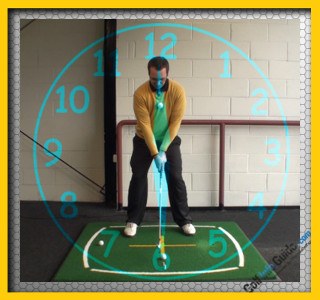
The Quarter Start Drill is likely the easiest exercise to perform and helps you understand weight shift in the golf swing. This drill can also be incorporated in both practice and the pre-shot routine while playing. You will perform this drill without a golf ball to start.
Take a club and get into your address position. Next, you will rotate the club a quarter way into the follow through and stop. Picture a clock around your body with address being 6 o'clock. In the quarter start position, the club should be set at 4 or 5 o'clock with at least 60% of your weight on your left side (right side left handed golfers). From there you will swing the club back to the top and through to the finish without pausing. You will repeat this swing five times and then hit a ball from the normal address position. During a round of golf, you can implement the drill by making it your practice swing. If you consistently perform the quarter start drill, you will quickly see better weight shift.
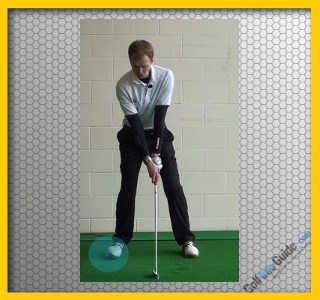
If you have a problem of Swaying or Sliding in the golf swing, you can perform the following drill to assist in decreasing the undesired movement. A Sway is more common in golfers, while a Slide is apparent in those more experienced.
During a practice session you can begin to correct a Sway by placing a golf ball under your right foot (left foot for left handed golfers) while keeping the inside of your shoe touching the ground. This will keep your weight on the inside of your foot at address. Take a swing that's 50% of normal speed and you'll feel an immediate difference on how your weight shifts. The idea is to eventually hit golf balls at full speed with a ball under your back foot. This will stop the Sway in your swing and you should see a dramatic difference in your ball striking.
To correct a Slide and have your hips rotating quicker in the follow through, you can place a golf ball under the left foot (right foot for left handed golfers). Making a slower golf swing than normal, the feeling you should have is where the front leg and knee straightens out just after impact. In a Slide, this knee will actually bow towards the target and rotate open. Once our knee and leg straighten, that's a direct result of the hip rotating. This rotation will increase your club speed and help you compress golf shots resulting in more distance.

A nice tip to get your swing started and assist with weight shift, is developing a little waggle before you hit the ball. Many novice golfers stand very still before they start their swing. Whereas, golf professionals always have their body moving prior to striking the ball. A waggle is more than just moving your club to and from the ball. A waggle in this case is having your weight moving from foot to foot. We refer to this as “starting your engine”. Just before you hit the shot make sure the weight is slightly in your left foot (right foot for left handed golfers) and with very little time to think, start your swing and finish to the target. Creating a waggle keeps your mind in the present and allows you to swing the club free.

What is the Correct Swing Weight Shift Takeaway to Downswing?
The golf swing is a motion which requires effort from the entire body, from your head to your toes. Right off the bat, you may realize that you have not been using your entire body effectively in your own swing during rounds gone by. Most amateur golfers fail to use their body the right way, instead just swinging the club with their hands and arms. The result of this kind of swing is predictable – the ball only travels a short distance, and it often misses the target to the right (for a right-handed golfer). If you are going to improve the quality of your ball striking going forward, it will be necessary to learn how to use your body the right way.
In this article, we are going to highlight the proper way to shift your weight from the takeaway on through to the downswing. The weight shift is an area of common misunderstanding in golf. Many players think they need to slide from side to side as they swing, which is completely the wrong way to approach the game. There should be no notable slide in your swing at any point – instead, the swing should be all about rotation. By the end of this article, you should have a clear picture of how your weight is going to move from start to finish in the swing. Once you put the proper weight shift into action, your ball striking will improve and you will hit longer shots than ever before.
Of course, that sounds quite easy as you sit reading it on your computer screen or smartphone. In golf, as you know, it is never that easy. This game is hard, and you are always going to have to work for your improvements. The key is to spend your time working on the right things. Now that you will have a clear understanding of how your weight should be moving as the club swings, you can spend your practice time in a productive manner. You will be getting closer and closer to a quality swing with each passing range ball, and the progress you are making will only motivate you to work even harder.
Many golfers choose to work on improving their weight shift as a method of adding distance to their shots, and that is certainly one benefit to consider. However, the even larger benefit is the improvement in consistently that you should experience. If you move your weight in the correct way swing after swing, you will be delivering the club to the ball on a consistent path – and your shots will trace a similar pattern in the air over and over again. No golfer is perfectly consistent from shot to shot, but using your weight properly will take you a long way toward a more repeatable swing.
All of the content below is based on a right-handed golfer. If you happen to play left-handed, please take a moment to reverse the directions as necessary.

Getting Started Properly
The start of the golf swing is something of a 'make-or-break' moment. You might not think it at the time, but making even a small mistake during the start of the swing can make it nearly impossible to recover. The golf swing builds on itself, on move at a time, so making an incorrect move early on is going to throw everything else off track. Work hard on the start of your swing and you might be surprised to see how easy the rest of the swing can be as a result.
So what does it take to get your golf swing started properly from a weight shift perspective? The following points highlight some of the keys to making a successful takeaway.
- Keep it quiet. There really shouldn't be much going on during your takeaway. The club is going to be moving, of course, and your arms will have to go along for the ride. It should be your shoulders which are doing most of the work at this point, as they rotate your upper body in order to move the club. Your hands should be quiet, and your weight should be staying in the same position it occupied at address. If there is any lateral movement with your center of gravity at this early stage of the swing, you are sure to run into trouble later on. In many ways, this kind of takeaway will feel 'too simple' at first. Many golfers think that there must be more to the swing than this, so they will add in unnecessary movements just to complicate matters. Don't fall into that trap. Keeping it simple is the way to go in golf, especially when it comes to the takeaway.
- Turning your back to the target. One of the best ways to visualize the backswing is to think about turning your back to the target as you go. By the time you reach the top of the backswing, your back should be facing the target and your eyes should still be looking down at the ball. Countless amateur golfers never manage to get into this position. They slide to the right instead of rotating properly, meaning they never get their back to actually face the target. You can do better than that. Turn away from the ball fully with your upper body while your lower body remains stable and steady. If you can get all the way to the top of the swing without having allowed your weight to shift in any direction, you will be well-positioned for an aggressive and powerful downswing.
- Stay inside of your right leg. You might have trouble understanding what it feels like to keep your weight in the same place as you swing. After all, you are rotating significantly during the backswing, so you might not think you are staying centered at all – even if you are. As another way of thinking about this point, you want to make sure your weight stays inside of your right leg throughout the backswing. It is common for golfers to let their weight drift out over the right leg – or even to the outside of the right leg – and poor results almost always follow from such a mistake. The key here is your right knee. Keep track of its position and don't let it drift away from the target as you go. As long as there is stability in the position of your right knee, you can be confident that your weight is in the right place for a powerful swing.
A great golf swing is always going to have to start with a great takeaway. If your takeaway fails, the rest of the swing has little to no chance of getting back on track. Simplicity is the key here, limiting your body movements in order to allow the club to trace the same path swing after swing. It is hard to convince yourself that simple is the right way to go, but the results should speak for themselves. If you are dedicated to a simple, efficient, balanced takeaway, the rest of your technique will improve as a result.
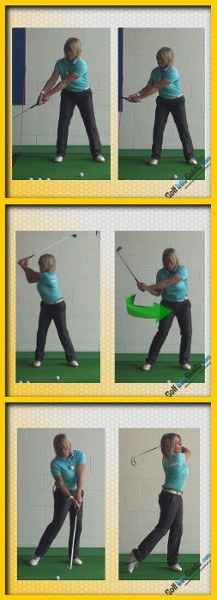
Firing Up the Downswing
It would be accurate to describe the backswing as a calm, peaceful motion. By comparison, then, it would be fair to say that the downswing is a violent action. You are going to accelerate the club aggressively through the ball, adding as much speed as possible before the moment of impact. While it is common for amateur golfers to focus on their arms and hands when trying to swing the club quickly, it is actually the way you use your weight which will determine your capability for power. Utilize the proper body motion in the downswing and you will be able to unleash a powerful strike through the hitting area.
Your weight in the downswing is going to be controlled by the movement of your hips. As soon as the club reaches the top of the swing, your hips should jump into action and take over. The left hip is going to open quickly toward the target, which will pull the rest of your lower body into position. This is not a move which can be made slowly or casually – you need to be committed to this motion if it is going to be successful. Quickly open your hips to the target and allow your upper body to lag behind for the time being. By creating separation between your upper and lower body, you will store up tremendous potential energy which can be unloaded as you get to the bottom of the swing.
As you might have noticed, we have not said anything about a 'weight shift' while talking about your downswing. The reason is simple – you don't actually want to think about shifting your weight at all. Sure, your weight is going to move during the downswing, but only as a result of the rotation taking place in your lower body. You should not be trying to slide your body from one side to the other. Doing so would be a mistake, and it would likely lead to a loss of balance and a poor strike when all is said and done. Think first and foremost about rotating your lower body in the downswing and let everything else fall into place from there.
With your lower body well underway, the most important thing you can do as the downswing continues is to keep your upper body out of the way for as long as possible. Basically, you want to let your lower body do all of the work while your upper body 'goes along for the ride'. This is where so many golfers go wrong. In a hurry to get the club down to the ball, many golfers force their hands down toward impact – rushing the swing and wasting the power they could have created if they had been more patient. Your lower body rotation is only going to translate into club head speed if you are willing to wait long enough with your hands and the club. Allow the lower body to clear the hitting area before whipping the club through the ball and sending the shot on its way. This technique might feel odd at first, but it is powerful. If you can give yourself enough practice time to learn this move, your entire game will take a huge step forward.
To recap, it is important to remember that there is no intentional weight shift in the golf swing. Your weight is only going to move as a result of your rotation, which should be driven by the shoulders in the backswing and the hips in the forward swing. The sooner you can learn to focus your swing on rotation, the sooner you will be able to take your ball striking to a new level. Get rid of any excess lateral motion in your swing and trade it in for a better turn. It is almost always the golfers who turn the best that come out on top at the end of the day.
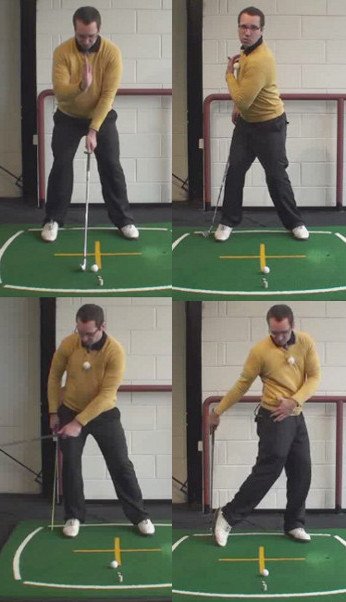
Common Weight Mistakes
There are a number of common mistakes amateur golfers make with regard to the weight shift, rotation, setup, and more. You need to keep your body weight in the right position both before and during your swing if you hope to strike clean shots time after time. Golf is a hard game to play even when your weight is in the right place – it is nearly an impossible challenge if you let your weight stray from the right spot.
The following list includes a number of common weight mistakes seen in the amateur game.
- Leaning toward the target at address. For some reason, a number of amateur golfers have the habit of leaning toward the target slightly when standing over the ball. It should go without saying that this is a mistake you need to avoid. At address, for any kind of 'standard' shot, you should be perfectly balanced with your weight directly between your two feet. You can vary this starting position when trying to create a unique shot, but in general, perfect balance is the way to go during the setup. By being balanced in your stance, you will have a much better chance to remain balanced while the swing develops.
- Trying to move from side to side. This is one that drives the average golf teacher crazy. Some golfers think that they need to slide from side to side in order to hit good shots – when in reality, nothing could be further from the trust. Golf is a rotational game, first and foremost, so you need to think about turning rather than sliding. As has been mentioned above, any lateral motion which takes place in your swing should be a byproduct of your rotation, not an intentional action. A rotational swing will allow you to develop significant power, and it will also help you to achieve clean contact. There is nothing good to say about a swing which slides from side to side, so stay as far away from this mistake as possible.
- Leaning back on your heels. When you think about balance in the golf swing, you usually think about how your weight is positioned from side to side. However, there is another half to that equation, which is how your weight is distributed from front to back. While it would be ideal to have your weight nicely balanced in this dimension as well, many golfers make the mistake of leaning back onto their heels while over the ball. Making such a mistake is harmful because it will be hard to complete a full turn while you are not balanced from front to back. You shouldn't be on your heels or your toes at address – you should be somewhere in the middle. Work on keeping your feet flat on the ground to improve your balance, and consider adding a bit of knee flex to make sure you 'sink' into your stance in a balanced spot.
- Leaning forward at the top of the swing. This can be a 'sneaky' mistake because it will slip into your swing just when you think everything is under control. Even if you get to the top of the swing with your weight nicely positioned, you might find that you lean out over the ball just as you start the transition down toward impact. Making this mistake is likely a sign that you are simply in too much of a hurry to hit the shot. Be patient, keep your weight in the middle of your feet, and let the swing take its time to develop. The ball isn't going anywhere, so you don't need to be in a rush to hit it.
Take a quick look at your current swing to make sure you aren't making any of the four mistakes listed above. If you are making one of these mistakes, set aside some practice time to address the matter during an upcoming visit to the range. Do your best to get rid of these problems quickly, as they will become harder and harder to erase as time goes by.
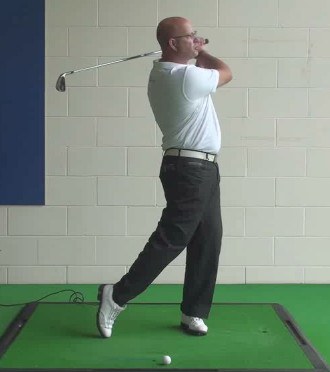
Checkpoint at the Finish
Most golfers don't think of the finish position as being particularly important. After all, the ball is already gone, so how can your finish actually affect the shot? Well, it can't really affect the shot, but it can give you a great indication of how well you executed your technique during the swing. If you arrive at a beautiful finish position, there is a good chance your swing was excellent as well.
If you would like to check your finish position to make sure it is living up to expectations, review the checklist below.
- Weight should be stacked on your left leg. When all is said and done, your weight should be almost completely on your left side as you watch the ball travel through the air. This is because you will have rotated your hips aggressively in the downswing, and that rotation will have pulled your weight onto the left side. Remember, the cause and effect here is important – your weight is on the left because of your rotation, not because you slid toward the target in the downswing.
- Your belt buckle is pointing toward the target. This is a great checkpoint because it confirms that you have rotated your hips nicely. Many amateur golfers fail to reach this position, as they use only their arms to swing the club down through the ball. As long as your belt buckle is facing the general direction of the target at the end of the swing, you can be confident that your lower body turn was a good one.
- Hold the pose. You should be able to easily hold your finish position until the ball has come back down to earth. If you are unable to do so, take that as a sign that you need to work on your balance earlier in the swing. Professional golfers almost always hold their finish pose until the ball has landed, and you should strive to do the same. Not only will this prove that you are balanced, but it will also help you follow your ball until it stops moving.
The title of this article is a bit misleading, as you really don't want to 'shift' your weight intentionally during the golf swing. With that said, you do want to rotate your weight, and you will wind up shifting to the left eventually as your rotation pulls you through the shot. Use the advice provided throughout this article to guide your upcoming practice sessions. As you continue to make progress in the way you use your weight during the swing, you should notice your shots begin to travel farther and farther than ever before. In addition to distance, you will be likely to gain significantly more control over your trajectories. Good luck!





